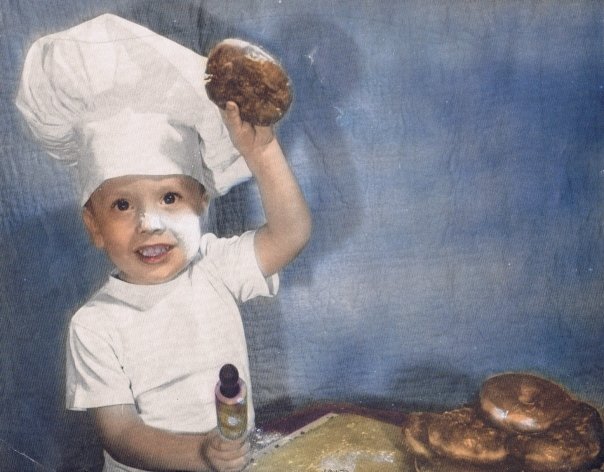 |
| I was already working on my triceps, rolling out dough, and building a portfolio as a donut model for calendars. No royalties, except what I ate. |
The origin of "O Holy Night" invoked memories, singing that beautiful song at our elementary school - Garfield. We were so backward, we called it a grade school then. Multi-syllables are the key to sophistication.
One of our teachers sang the obbligato to "O Holy Night", and she had the voice of an angel. One of her students became famous in the opera world, because of the influence of that teacher. My mother said of the teacher, in a hushed voice, "She was first soprano in the Augustana College Choir."
We were so backward, we had a Christmas program every year at Garfield. Each class would sing actual Christmas hymns and songs with parents and teachers in the audience. I would scan the audience for my mother, who was teaching there. She would always give me a big smile and I smiled back, could not help it.
Moline was a small town. When my father plugged in his electric shaver, the trolley car would slow down.
We did not know that we were living in a peaceful paradise. Some bad things did intrude, but my mother always explained them to us:
- "None of your business."
- "You are not old enough."
Later, I was learning about nutrition at the Melo Cream Donut Shop. Germans have a tradition of eating jelly-filled bread donuts (no hole of course) for Christmas-New Year's. We had to have trays of them ready because once-a-year customers would come in to buy a dozen.
 |
| This was Photoshopped by a Moline friend. |
The tradition comes from Germany, so the donuts were called Berliners or Bismarcks, the first after the town where the baker came from, the second after the famous leader. People used both names in Moline.
Making them was not simple. The filling had to have the right texture, so two kinds were mixed together (my task). That gave me a permanent loathing for the finished product, except when I was especially hungry.
The filling was squirted into the donut by a pedal driven device, later by an electrical motor. I was given the opportunity to learn how. After several jelly blow-outs, I was retired from that task. As
Marlon Brando said in "On the Waterfront" - I coulda been something, I coulda been a contender.
I was entrusted with icing the heavy donuts and waiting on the customers. Once a year we had customers with German accents. They grinned at the thought of enjoying those donuts.
People complained they were the most expensive donuts. But these desserts - or the main course - started as yeast dough which had to rise in a huge bowl the first time. Then it was rolled out on a smooth wooden area and cut into little circles of raw dough, placed on wooden boards, finishing in a proofing cabinet. They did not go into the fryer until they were light and puffy with yeast at work. Then they were slid into the hot shortening vat (a great way to get burned) and turned over with wooden sticks. Next they were pulled out on a metal screen and set aside for cooling.
Left-over raw dough went downstairs into the cooler to be used in the next batch of bread dough. That was, according to legend, the best way to have great dough for bread donuts, based on the origins of sourdough bread, where a yeast culture is named and saved, passed from neighbor to neighbor.
The trip taking the extra dough downstairs was not a chore, even though the wooden steps were worn and tricky, a cooling rack parked over half of it. Downstairs errands were the perfect way to nick a warm Danish on the way down, because they came out of the oven and could not be iced until cool.
 |
| This was another calendar pose, which took place in an apple orchard. |



